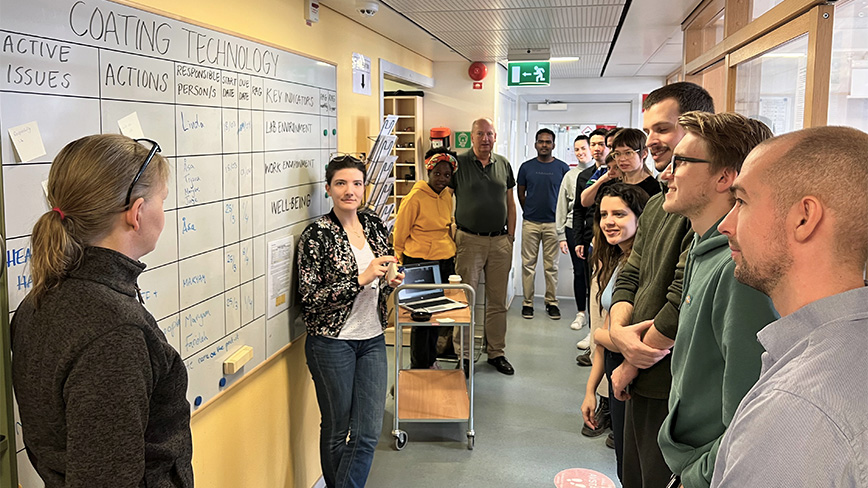Pulse meetings an appreciated form of APT

For several years now, the Division of Coating Technology at CBH has replaced their more traditional group meetings with short "pulse meetings" every Friday.
”Our approach with pulse meetings, separate research group meetings and Monday seminars, works very well and feels much more efficient and effective compared to the traditional whole group meetings we had before. This seems to be the general perception among the divisions’ members,” says researcher Linda Fogelström.
Pulse meetings are short meetings (15 minutes) where the whole group discusses matters concerning the Division of Coating Technology. In addition to the pulse meetings, there are also separate occasions where research issues are discussed in smaller constellations. So at the puls meetings, they actually address everything other than just the research, according to Linda Fogelström.
“At 9.45 every Friday, we meet in the corridor outside the kitchen where we have our notice board. If you cannot participate on site, you can participate via Zoom via a computer that one of the participants holds up. We go through current cases that are posted on the board, it can be for example "the coolers in the lab need to be inventoried and cleaned" or "the micropipettes need to be calibrated".”
No long discussions
During the pulse meeting, there should be no long discussions and the idea is not to resolve the issues raised during the meeting itself. At the meeting, you should only appoint the responsible persons and groups for each case and review the status of the various ongoing cases.
“Before, we had regular group meetings with the entire division, with both scientific presentations and research discussions, and we went through matters concerning the daily work. However, these meetings became very long and the efficiency in resolving problems that arose was very low; the same issues tended to recur during several meetings in a row without any action being taken, sometimes because it was unclear who was responsible and sometimes because they were forgotten,” says Linda Fogelström.
Inspiration from industrial collaborations
The Division of Coating Technology received inspiration for their pulse meetings from its partners in the industry, says Head of Division Eva Malmström Jonsson.
"We started with this 4-5 years ago after inspiration from partners and took advantage of the fact that a couple of then doctoral students had experience of this from previous jobs in the industry," says Eva Malmström Jonsson.
RAG survey
Every two weeks, the division also conducts a RAG survey in connection with the pulse meeting, where participants can color their own condition in relation to three areas: "work environment", "lab environment" and "well-being". RAG stands for Red Amber Green, precisely because these are the colors you use to signal how you yourself feel that the status is in the various areas. The RAG survey is done by the participants checking the status of each note that is collected anonymously at the meeting.
“In this way, we regularly take the tempo of how things are in the different areas according to the department members. If you enter red or orange, you are asked to give a comment on what is not at the top, so that we can try to make improvements accordingly,” says Linda Fogelström.
Text: Jon Lindhe
